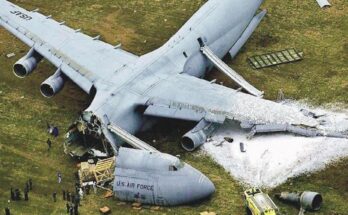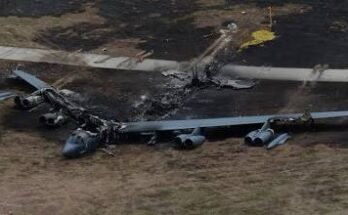
Martin B-26 Marauder with Heavy Flak Damage Over Europe
The Martin B-26 Marauder, a twin-engine medium bomber, was one of the most formidable aircraft in the U.S. Army Air Forces’ arsenal during World War II. Designed for speed, durability, and precision bombing, the B-26 played a crucial role in the European theater. However, its missions were fraught with danger, especially from German anti-aircraft defenses. One of the greatest threats to these bombers was flak—intense barrages of anti-aircraft fire that could shred an aircraft mid-flight.
During bombing raids over Nazi-occupied Europe, B-26 Marauders often faced a gauntlet of enemy fire before reaching their targets. German flak batteries, positioned strategically around cities, military installations, and transportation hubs, unleashed devastating clouds of high-explosive shells. The explosions sent lethal shards of metal ripping through the air, posing a grave danger to both the aircraft and its crew. The B-26’s ability to withstand such punishment was a testament to its rugged design and the skill of the men who flew it.

One of the most harrowing experiences a B-26 crew could endure was taking heavy flak damage yet still managing to return to base. A Marauder that had been hit often displayed gaping holes in its fuselage, shredded control surfaces, and sometimes even damaged engines. In many cases, the crew had to improvise, relying on teamwork and ingenuity to keep their crippled bomber aloft. Pilots fought to maintain control while gunners continued to fend off enemy fighters hoping to finish the job.
The sight of a B-26 limping back to friendly airspace was a powerful testament to the resilience of its crew. Some aircraft returned with one engine dead, a damaged tail section, or even missing parts of the wings. Despite the odds, many crews managed to land safely, often greeted by astonished ground crews who marveled at how the aircraft had remained airborne. The stories of these damaged bombers became legendary, showcasing both the durability of the B-26 and the unwavering determination of the airmen who flew them.
One notable aspect of the B-26 Marauder’s combat history was its ability to absorb damage and still perform effectively. While the aircraft initially had a reputation for being difficult to fly due to its high landing speed, experienced pilots learned to master its handling. By the latter part of the war, the B-26 boasted one of the lowest loss rates of any bomber in the U.S. fleet. This statistic is remarkable, considering the extreme dangers of flying bombing missions deep into enemy territory.

The bravery of B-26 crews under heavy flak fire remains an inspiring chapter in the history of World War II aviation. Whether completing their mission despite crippling damage or making miraculous returns to base, these airmen demonstrated courage and resilience in the face of overwhelming odds. The Martin B-26 Marauder’s legacy as a tough, reliable bomber endures, remembered not just for its design but for the brave men who flew it through the storm of enemy fire.


